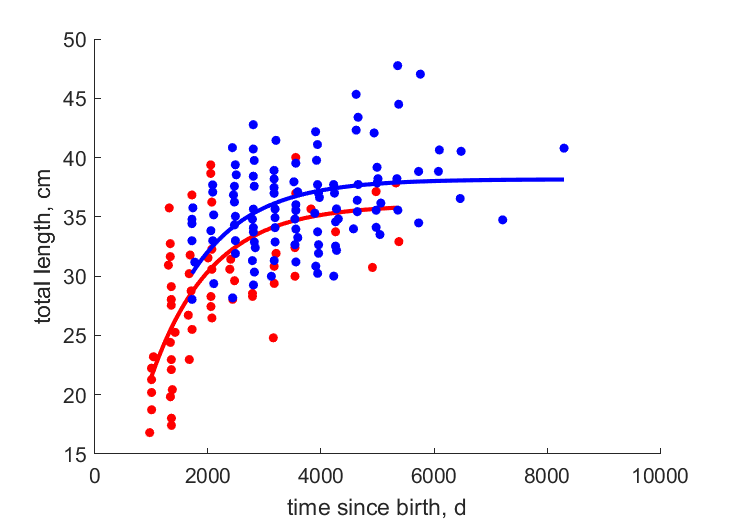Predictions & Data for this entry
| Model: abj | climate: MB | migrate: | phylum: |
| COMPLETE = 2.5 | ecozone: MANE | food: bjPz, jiCi | class: |
| MRE = 0.078 | habitat: 0jMp, jiMr | gender: Hsff | order: |
| SMSE = 0.014 | embryo: Mp | reprod: O | family: |
Zero-variate data
| Data | Observed | Predicted | (RE) | Unit | Description | Reference |
|---|---|---|---|---|---|---|
| am | 1.058e+04 | 1.048e+04 | (0.009951) | d | life span | fishbase |
| Lp | 25.6 | 23.04 | (0.09985) | cm | total length at puberty | fishbase |
| Li | 65.9 | 66.35 | (0.006843) | cm | ultimate total length | guess |
| Wwb | 0.000195 | 0.0001918 | (0.01616) | g | wet weight at birth | MuncAnde2010 |
| Wwp | 201 | 154.5 | (0.2314) | g | wet weight at puberty | fishbase, GordMoli2000 |
| Wwi | 3700 | 3688 | (0.003276) | g | ultimate wet weight | fishbase, GordMoli2000 |
| GSI | 0.012 | 0.01203 | (0.002774) | g/g | gonado somatic index | MuncAnde2010 |
Uni- and bivariate data
| Data | Figure | Independent variable | Dependent variable | (RE) | Reference |
|---|---|---|---|---|---|
| tL_f |   | time since birth | total length | (0.1265) | VillAlon2013 |
| tL_m |   | time since birth | total length | (0.08599) | VillAlon2013 |
Pseudo-data at Tref = 20°C
| Data | Generalised animal | Labrus bergylta | Unit | Description |
|---|---|---|---|---|
| v | 0.02 | 0.01973 | cm/d | energy conductance |
| p_M | 18 | 19.59 | J/d.cm^3 | vol-spec som maint |
| k_J | 0.002 | 0.002 | 1/d | maturity maint rate coefficient |
| k | 0.3 | 0.5326 | - | maintenance ratio |
| kap | 0.8 | 0.9873 | - | allocation fraction to soma |
| kap_G | 0.8 | 0.8021 | - | growth efficiency |
| kap_R | 0.95 | 0.95 | - | reproduction efficiency |
Discussion
- males are supposed to differ from females by {p_Am} only
Facts
- length weight: Ww in g = 0.00955*(TL in cm)^3.07 (Ref: fishbase)
- Protogynous hermaphrodite: females may change to males; all are born as female (Ref: Wiki)
Bibliography